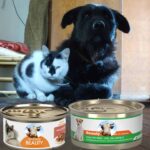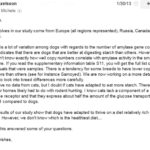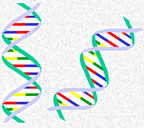Why Did My Dog Or My Cat Develop Digestive Tract Issues While Other Pets Didn’t?
IBD, Intestinal Lymphoma, Chronic Diarrhea, Pancreatitis, Gall Bladder, Liver Issues, Diabetes etc.
Ron Hines DVM PhD
 Are Pet Food Preservatives Dangerous?
Are Pet Food Preservatives Dangerous?
 The Meat In Commercial Dog And Cat Foods
The Meat In Commercial Dog And Cat Foods
 Intestinal-related Problems In Dogs
Intestinal-related Problems In Dogs
 Liver And Gall Bladder Disease In Your Cat – Cholangiohepatitis – Triaditis
Liver And Gall Bladder Disease In Your Cat – Cholangiohepatitis – Triaditis
 Intestinal-related Problems In Cats
Intestinal-related Problems In Cats
Many health issues develop because dogs and cats have genetic tendencies that make them more likely to occur. The same as with you or with me. In our pets, much of those tendencies are the results of selective breeding for size, shape, abilities or temperament. For example, golden and Labrador retrievers are loving and tolerant, but more prone to certain tumors than other breeds. (read here) Japanese bobtails and American Shorthair cat breeds rank highest in friendliness and their craving for affection. (read here) But the Bobtail breed is more predisposed to other spinal abnormalities and the Shorthair breed to heart issues. Those are things you and I cannot control. But the genetic destiny of your dog or your cat is greatly modified by its lifestyle and its life events. You have a lot of control over that. Particularly when it comes to what you feed your pet, how you manage its veterinary needs, and how well you control its exposure to the perils of the great out-of-doors. This article explores the relationship between chronic inflammatory diseases of the digestive system, certain cancers, and diet.
In humans, the increased number of chronic digestive tract problems parallels our switch from a farmer-provided natural food diet to a diet of highly processed, highly refined, industry-provided foods containing many unhealthy additives. (read here & here) Some are added for eye-catching appeal, others for taste and aroma, others to greatly increase the product’s shelf life. Health takes a back seat to sales and profits. Why should it be any different in your cat or your dog?
There was a time when veterinarians diagnosed intestinal parasites, virus or bacteria as the leading causes of intestinal inflammation, diarrhea and vomiting. Here in the developed world, we veterinarians have been quite successful in preventing and treating those issues. But chronic intestinal, liver, gall bladder and pancreatic inflammation are now the major causes. Read about that in cats here and in dogs here. It is no coincidence that all the organs affected are involved in processing incoming pet food nutrients, additives, preservatives and ingested toxins. I believe that the common dog and cat foods of today contain unhealthy high levels of carbohydrates in one form or another. Carbohydrates that your cat and your dog’s digestive tract and body were not designed for. The only reason they are put there is to increase the profit margins of the companies that sell them.
Cats became our partners considerably later than dogs. (read here) So, dogs have had much more time to genetically adapt to these unnaturally high carbohydrate, starch-based ingredients. Dogs adapted by producing more amylase than their ancestral wolves did. Even now, some dogs are still negatively affected by their high-carb diets. (read here, here & here)
Even now, some dogs are still negatively affected by their high-carb diets. (read here, here & here)

The Genetic Component You Can’t Change
Veterinarians know that certain breeds of dogs and cats are more susceptible to inflammatory intestinal issues than others. Veterinarians know considerably more about the genetics of dog breed susceptibility than about the susceptibility of specific cats. (read here & here) It appears that various mutations the the genes that regulate Interleukin-10 play a part. One of the jobs of interleukin-10 is to keep inflammation under control. For example, inflammatory colorectal polyps in dachshunds are thought to be genetically predisposed. Besides polyps, about a third of them have evidence of generalized gastrointestinal inflammation. Another evidence of strong genetic involvement is that if one kitten or puppy in a litter develops chronic intestinal issues, it’s very likely that others in that family line did or will as well. Another set of gene mutations that are suspected to predispose dogs to intestinal problems are called toll-like receptors. (read here) They function in particular immune system cells called Th2 cells. (read here) The end result of their activity is the generation of inflammatory cytokines.
Your Dog And Cat’s Diet
I only drew the image of corn that you see above as a common example. It doesn’t matter if it’s whole grain wheat, oats, barley, peas, sweet potatoes or potatoes. It doesn’t matter if they are “organic” or contain no GMOs. It doesn’t matter if they are described as delicious, mouth watering, tasty or yummy. It doesn’t matter if they are crunchy, munchy, crispy or chunky. It doesn’t matter if they are fresh, healthy, grilled, toasted, choice, or roasted. Of if they are drizzled, smothered, sliced, sprinkled, or yummy. These starchy vegetables offer no health benefits to your dog or cat. They are in there to increase company profits by lowering the amount of the more expensive meat ingredients, as well as to bind dry kibble pellets together in their traditional livestock pellet extrusion process. (read here & here)
When companies mix carbohydrates and meat products at high temperature and pressure to produce their products, they introduce the danger of creating new toxic compounds. Two of them are heterocyclic amines (HCAs) and polycyclic aromatic hydrocarbons (PAHs) (read here) HCAs are created when creatinine and meat-derived amino acids react together under high temperatures (392 F/200 C). Even at 212 F/100 C) that process begins. Fat content also influences their creation. (read here) The filler carbohydrates in these kibbles and cans, such as oat groats, brewer’s rice, pea protein and soybean meal, are also high in nitrogenous proteins. In the manufacturing process they and the highly processed meats these products contain have the potential to liberate unhealthy N–nitroso compounds. (read here)
Other Than The Possibility Of Creating Toxic Substances, How Else Are These Diets Unhealthy?
Your cat or dog depends on a large number of living organisms in its digestive tract to maintain its health, its intestinal flora (aka microbiota or microbiome). Over eons, this group of organisms and your pet have learned to live in harmony – each supporting the other in various ways. Feeding unnatural products interrupts this harmony (dysbiosis). High carbohydrate diets favor the growth of yeasts such as candida. (read here) The amount of carbohydrate versus protein in a dog’s diet has profound influences on which organisms will thrive in your dog’s digestive tract. On diets high in protein and low in carbohydrates, faecalibacterium, bacteroides, and faecalibacterium thrive. (read here) Similarly in cats, kittens fed a high-protein low carbohydrate diet show greater intestinal flora richness and microbial diversity. (read here) Canned cat diets tend to have less carbohydrate content than dry cat kibble. So, the intestinal microbial flora of cats fed canned diets is more diverse than those fed dry extruded kibble. (read here & here) These positive bacteria are very fragile. They are anaerobic bacteria, so air is toxic to them. That is why none are included in commercial veterinary probiotic products. Read more about probiotic products farther along in this article.
Emulsifiers, Jellers and Thickeners
When it comes to canned pet food, emulsifiers are added to disguise the amount of water in the can that you just bought. A typical can of cat or dog food is 70-80% water. The label often calls that “water added for processing”. That appears to be the maximum amount their products can conceal without it being apparent to you. Lobbyists see to it that the FDA and the USDA and the FTC do not interfere. So, although trickery has been performed, no rules have been broken. There is a growing body of evidence that these emulsifying/thickening agents drastically alter the type and number of bacteria found in your pet’s intestine. (read here) Emulsifiers also have the potential to encourage digestive tract inflammation by stripping the pet’s intestinal wall of its protective mucus layer. Without that separating barrier, bacteria and undigested pet food ingredients are much closer in position to your pet’s immune system cells. Perhaps that forces the immune system cells to make snap decisions regarding the potential danger of food and bacterial antigens. Decisions that could be made in error. (read here) Some of these additives are also irritating in their own right.
Pet food manufacturers will reply that all these additives were approved by the FDA or the EFSA. That is true. However, those studies were done long ago – long before intestinal inflammation problems began to rise in humans, dogs and cats and long before scientists had any knowledge of the importance of the intestinal biota. When clearance was given to those additives, knowledge of how the immune system’s memory and defenses functioned was also rudimentary. The most common emulsifiers/thickeners in canned pet foods are carrageenan, cassia gum, guar gum, cellulose gum/ (aka carboxymethylcellulose), and xanthan gum that you might see on the ingredient labels. The kelp and saccharina are added for their similar thickening function – not because of any known healthful effects in dogs or cats.
In one study, carrageenan, at least in the presence of other cancer-causing agents, was thought to accelerate the tumor process in animals. (read here) It has pro-inflammatory effects as well. (read here) cassia gum has no nutritional value. The EFSA found that cassia gum had the potential for irritating and sensitizing effects. (read here & here) Guar gum has almost eight times the water-thickening potency of cornstarch. It is cheap and only small quantities are required for adding a stiff texture to almost anything – even pure water. It is used a lot in the food industry. But the biggest use today is in the petroleum fracking process and in sewage plant water purification. It appears to have the potential to be irritating in its own right and to sensitize the immune system. (read here, here & here) Maltodextrin is another thickening and binding agent loved by the pet food industry. It is often added to commercial pet treats (particularly the soft or chewy ones). It is also the major ingredient in the Fresh Breath Cat Treats sold at PetSmart. Maltodextrin was found to disrupt the colon’s mucus barrier and allow bacteria to cling tightly to the intestinal walls. (read here & here) Products like these that alter optimal conditions in your cat and dog’s intestines have the potential to effect processes far from its digestive tract – studies in children revealed that. (read here & here)

Are Probiotic Pastes Likely To Help?
I mentioned earlier that I have little faith in these products. Of the 42 different bacteria types identified in the stools of health dogs, none that I know of are included in the probiotic pastes and additives sold for dogs and cats. (read here) There appears to be very little difference between the normal intestinal flora of cats and the normal intestinal flora of dogs, so I doubt that these products are of any long-term help for your cat either. (read here) Prescription diets like Hill’s i/d line, Purina’s EN or Royal Canin Gastrointestinal are often bland enough to calm your pet’s intestines – at least for a while. But they do not address the underlying problem of dysbiosis. The better option is a fecal transplant. (read here) Simple co-habitation and food sharing with a health pet allows bacterial transfer too. After all, that’s how they got their intestinal flora in the first place.
Are Pet Diets Really As Meaty And Natural As The Companies Would Have You Believe?
No. Click on the image above or click here to read more about that.
If The Companies And Veterinary Nutritionists Know Carbohydrates Are Undesirable, Why Do They Include So Much Of It In Their Products?
There is one major reason and one minor reason: The major reason is that grain and “grain free” plant ingredients are cheap in comparison to meat. The minor reason is the dry kibble manufacturing process itself. Carbohydrates are the cement that glue the other ingredients together in the extrusion process. When the product is canned, it is only added for the first reason. Click on the image above or click here to read more about that.
Are There Additives and Compounds In My Pet’s Foods That Could Potentially Increase Its Chances Of Developing Digestive Tract Issues?
Probably so. Click the image above or click here to read more about that.
If I Put My Pet On A Low-carb Additive-free Diet, Will It Get Better Or Maybe Even Be Cured?
By all means try. My preference is always that you prepare your dog or your cat’s diet at home from the same meat and produce you purchase for yourself. You can read more about if you click the image above or click here. Unfortunately, your pet’s immune system is involved in chronic digestive issues. New diets do not change decisions already made by your pet’s immunological memory. Drugs like corticosteroids or cyclosporin can suppress that memory and lead to improvement; but that same immunological memory is the one that protects your pet against infectious disease. I am not a fan of raw diets, particularly those that are sold, pre-packaged in stores. A lightly cooked diet is always safer. (read here)
You are on the Vetspace animal health website
Visiting the products that you see displayed on this website help pay the cost of keeping these articles on the Internet.



